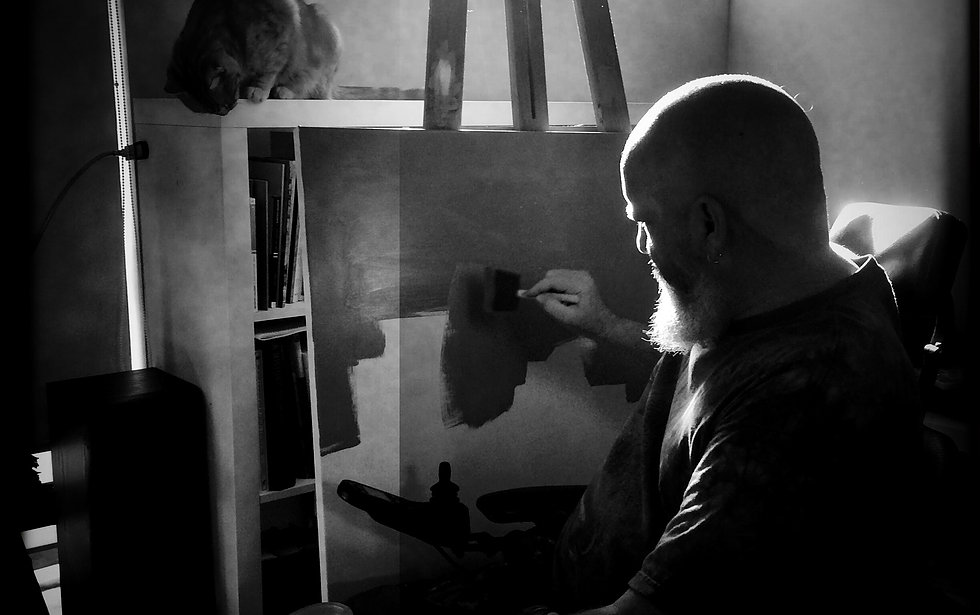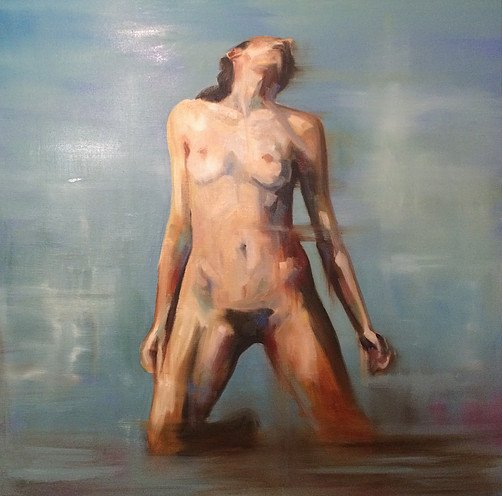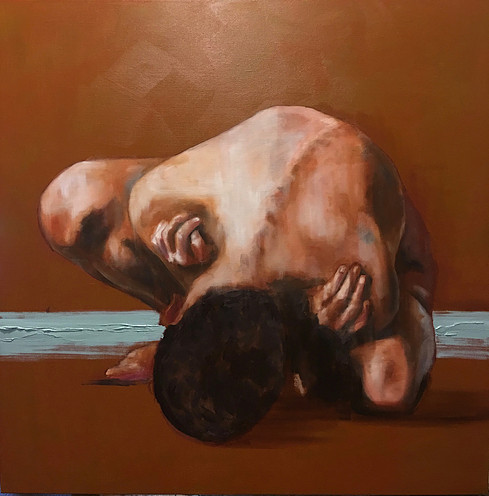#027
The Interview:
Andrew Grant
The artist & volunteer
Words Amy Willing

If you’ve ever visited us over the weekend, you might have said g’day to Andrew Grant. In 2013, Andrew held his first group show at 107, and he’s been volunteering behind the gallery desk ever since.
If you follow him on Instagram, you’ll see the evolution of his latest project: 35 paintings in 10 months, culminating in an exhibition here at 107 in March next year. You’ll also see his constant companion, Pickle the studio cat.
He’s built up a pretty solid body of work already, but Andrew only started painting a few years ago. His skill is the result of a lot of hard work, and we wanted to know a bit more.
Who are you?
I’m a painter. Really, that’s the core of who I am. I love to paint.
How did you get into art as a career?
I had always been interested in drawing and painting, but my family more or less discouraged me from doing it. For a long time I just did jobs. I worked in hospitality and national parks, doing physical work. Then in my late twenties I was diagnosed with a degenerative neuromuscular disease. As my physical work tapered off, I spent more and more time making art. In the end I just decided to throw myself at it. I did three years of TAFE, and then a Bachelor of Fine Art at COFA. I wanted to go to TAFE because they teach you a strong, skills-based practice, and I really applied myself to that. COFA is a more conceptually based platform, and it helped to enhance that side of my practice, just to balance things out.
Can you tell us what you’re currently working on?
At the start of the year I applied for a grant through a disability arts organisation called Accessible Arts. I applied for 35 canvases, an electric easel to help facilitate painting, framing costs, and a videographer to document my process. The documentary is going to be about pathways into the arts for people with a disability. The whole thing is going to culminate in an exhibition here at 107 in March next year, with me doing talks about the benefits for people with a disability entering the arts: why they should do it, how they can do it, and what they can expect to get out of it. I want to build something that will be a legacy for the disability arts sector.

You paint a lot of figures, particularly female ones. What draws you to the human body as a subject?
What really engaged me with painting was capturing the play of light on form, and allocating colours to convey that. I love the way that, when you think of the colours that make up flesh tone, you think pinks and browns, but it’s actually blues and greens and all these other colours that make up shade and light. I found that fascinating.
I don’t deliberately choose to draw mainly women. I source my images from life drawing magazines and catalogues, and I ask people to pose for me. There’s something about the way that women are captured in film and images that is different to the way that men are captured. There’s a greater variety in the way that women are portrayed. I do try and make at least a quarter of my paintings men, but they’re just not as much fun to paint.
You talk about the ‘ugly stage’ in your paintings – in fact, you talk about them almost like they are living objects. Can you tell me about this relationship you have with creativity?
Honestly, sometimes I feel like I’m just channelling something, and that I’m completely removed from the process. I feel like the instrument. At times I don’t know where it comes from, I’m just there.
I start off with an idea of how I want a painting to look at the end, and then I try and work towards that. I’m always in love with the painting at the beginning. Those first few strokes, I feel something quite magical. It has all this potential because it’s outcome is not defined yet. Quite often I just want to stop there. I want to enjoy that. But by pushing forward, it inevitably goes to this point where I don’t like it. I hate it. I often want to throw it out. I don’t want to finish it, I don’t want to look at it. It’s like your body rejecting a transplanted organ. That’s the ugly stage! But then I push on, and hopefully it gets back to the point where I love it again.
Have you ever had a project that didn’t?
Heaps! I take them downstairs, leave them outside on the footpath, and go back upstairs to the balcony and watch people come along and grab them. They’re the works that I just can’t live with any more. It’s irreconcilable differences, we’re never going to make it work, they just have to leave.

How did you become involved with 107 and why?
I didn’t really want to become involved with 107 Projects. A friend of mine talked me into it. He was working and volunteering here, and he said why don’t you come in and mind the gallery? I thought, well, physically I don’t know what I can do, but he said all you’ve got to do is sit behind the desk and talk to people. I’ve been doing it ever since. It’s been really good for me because I don’t really like talking about art. By coming here and minding other peoples’ exhibitions, I get to learn what their work is about and how to articulate that to visitors that come along, and it’s made me a lot more comfortable talking about my own work.
What’s something in your life that you’re proud of?
The highlight of my artistic career for me so far, was when Jess (Managing Director of 107 Projects) asked me to represent 107 Projects at Sydney Contemporary in 2015.
Also, Sydney Story Factory asked me to donate work for their fundraiser, and it sold for a lot of money. I was really happy because I was in company with twenty or thirty well-known Sydney artists, and my work sold for a decent price in amongst theirs. I felt validated.

What are you reading at the moment?
Kandinsky. Concerning the Spiritual in Art. I think I’m going to stop reading it until I finish the next five paintings, because I think it’s going to be a game-changer.
Where do you like to hang out when you’re not working?
Well, my studio’s in my home. It’s my little art cave. If I’m hanging out anywhere and it’s not at home, it’s generally here. I love coming in to see the different work. I especially love it when there’s a painting exhibition on.
Where can people find your work?
www.andrewgrantart.com. Also at the exhibition in March!
